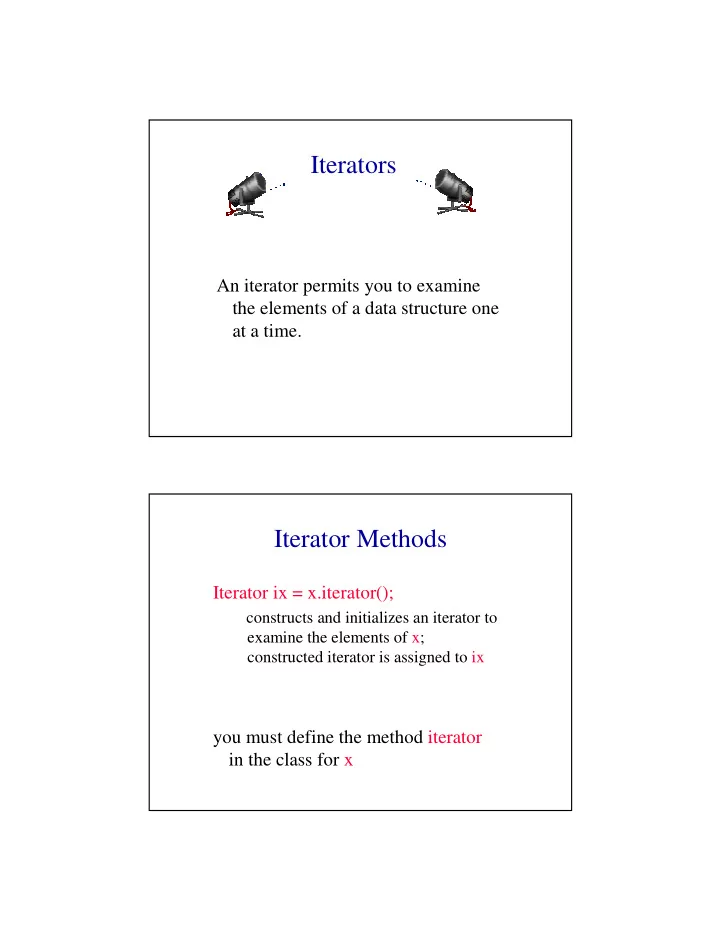

Iterators An iterator permits you to examine the elements of a data structure one at a time. Iterator Methods Iterator ix = x.iterator(); constructs and initializes an iterator to examine the elements of x; constructed iterator is assigned to ix you must define the method iterator in the class for x
Iterator Methods ix.hasNext() returns true iff x has a next element ix.next() throws NoSuchElementException if there is no next element returns next element otherwise Optional Iterator Method ix.remove() removes last element returned by ix.next() throws UnsupportedMethodException if method not implemented throws IllegalStateException if ix.next() not yet called or did not return an element
Using An Iterator Iterator ix = x.iterator(); while (ix.hasNext()) examine(ix.next()); vs for (int i = 0; i < x.size(); i++) examine(x.get(i)); Merits Of An Iterator • it is often possible to implement the method next so that its complexity is less than that of get • many data structures do not have a get by index method • iterators provide a uniform way to sequence through the elements of a data structure
Java’s Array Linear List Class java.util.ArrayList Cadillac version of our ArrayLinearListWithIterator Linked Representation • list elements are stored, in memory, in an arbitrary order • explicit information (called a link) is used to go from one element to the next
Memory Layout Layout of L = (a,b,c,d,e) using an array representation. a b c d e A linked representation uses an arbitrary layout. c a e d b Linked Representation c a e d b firstNode pointer (or link) in e is null use a variable firstNode to get to the first element a
Normal Way To Draw A Linked List firstNode null a b c d e link or pointer field of node data field of node Chain firstNode null a b c d e •A chain is a linked list in which each node represents one element. • There is a link or pointer from one element to the next. • The last node has a null pointer.
Node Representation package dataStructures; class ChainNode { // package visible data members Object element; next ChainNode next; element // constructors come here } Constructors Of ChainNode null ChainNode() {} null null ChainNode(Object element) element {this.element = element;} ChainNode(Object element, ChainNode next) next {this.element = element; element this.next = next;}
get(0) firstNode null a b c d e checkIndex(0); desiredNode = firstNode; // gets you to first node return desiredNode.element; get(1) firstNode null a b c d e checkIndex(1); desiredNode = firstNode.next; // gets you to second node return desiredNode.element;
get(2) firstNode null a b c d e checkIndex(2); desiredNode = firstNode.next.next; // gets you to third node return desiredNode.element; get(5) firstNode null a b c d e checkIndex(5); // throws exception desiredNode = firstNode.next.next.next.next.next; // desiredNode = null return desiredNode.element; // null.element
NullPointerException firstNode null a b c d e desiredNode = firstNode.next.next.next.next.next.next; // gets the computer mad // you get a NullPointerException Remove An Element firstNode null a b c d e remove(0) firstNode = firstNode.next;
remove(2) firstNode null cc b a b c d e beforeNode first get to node just before node to be removed beforeNode = firstNode.next ; remove(2) firstNode null a b c d e beforeNode now change pointer in beforeNode beforeNode.next = beforeNode.next.next;
add(0,’f’) firstNode null f a b c d e newNode Step 1: get a node, set its data and link fields ChainNode newNode = new ChainNode(new Character(‘f’), firstNode); add(0,’f’) firstNode null f a b c d e newNode Step 2: update firstNode firstNode = newNode;
One-Step add(0,’f’) firstNode null f a b c d e newNode firstNode = new ChainNode( new Character(‘f’), firstNode); add(3,’f’) firstNode newNode f null a b c c d e beforeNode • first find node whose index is 2 • next create a node and set its data and link fields ChainNode newNode = new ChainNode(new Character(‘f’), beforeNode.next); • finally link beforeNode to newNode beforeNode.next = newNode;
Two-Step add(3,’f’) firstNode newNode f null c a b c d e beforeNode beforeNode = firstNode.next.next; beforeNode.next = new ChainNode(new Character(‘f’), beforeNode.next);
Recommend
More recommend